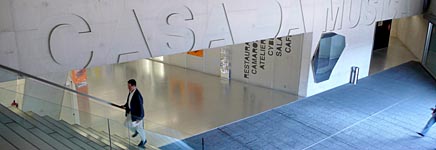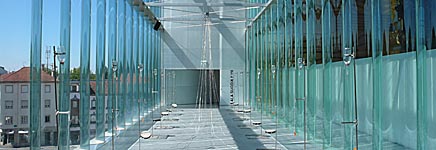

BackStory is an Archinect series that focuses on personal experiences of well-known buildings from those who are closest to them: docents, owners, janitors, occupants, and others. This is the expanded view or the bonus features that we may add to the official documentation of a project. Each entry in this series is a story about the building told from an intensely personal perspective.
Editor's note: Having completed a tour of the Casa Da Musica and then said our goodbyes, I was snapping some pics of the building's lobby when Alvaro, my tour guide, approached me again and whispered, "have your photo time later, follow me!" Knowing that my friend and I were architects, he wanted to show us one more thing: the service elevator. Designed to hold 113 people or a grand piano, it's literally a moving room. The official tour was enthusiastic and informative, but here, in this cavernous elevator and a smile still on his face, I could tell that Alvaro was truly a devotee of the Casa Da Musica. It's alive for him, as it seems to be for many in Porto.
Campo went on to tell us about the difficulties of getting the local police to allow kids to skate on the wavy plaza: the Casa's administration wanted the building to be a second home for those kids but the police saw it as a threat to their long awaited (and very expensive) cultural centerpiece. In the end, the Casa won and its plaza may now be skated freely. What follows is Alvaro Campo's own telling of this tale, the BackStory of Casa Da Musica as the civic heart of Porto.
Ever since the finishing touches of building itself, we’ve been quite aware of what technically goes on inside Casa da Musica. It works. We know the plans by heart, we’ve seen the pics, we’ve dreamt of going up the main staircase and going down the copper elevators…
What most of us aren’t aware is that the Casa also has a heart. It feels us. It beats and twitches when things go right. It sighs when things go wrong. Thankfully, they seldom do.
Since it opened (wide) its doors an intense appropriation of space, both inner and outer has been carried out by most city dwellers.

Its alien crystalline shape was thrust from outer space into the very centre of Oporto’s central business district. Upon landing it created the shock waves that limit the plaza where it’s set. The seemingly barren landing place quickly became a popular playground for skaters, roller bladers and such crowds. The Casa rejoiced. "Here they are at last!"
The intense care that most of the house workers foster for these young crowds has shown its worth. These youngsters consider the Casa an extension of their field of dreams. Talking to them quickly brings you back to that remote memory of your own playground at school… The Casa invites them over for a drink after the odd spin or twelve and they accept gladly. It is after all, their own Casa. They also live there.

After the drink and the chit chat between themselves about this or that maneuver, they take home flyers, they consult the artistic program, they interact with the musical sculptures and installations, they consider coming back that same night and bring their friends to an electro-pop concert… some, braver, even try a classical concert. The Casa giggles. "That’s the spirit!"
The following week we get to see these carefree brothers and sisters holding the hands of their (even) younger siblings over to a workshop, a musical training session, a musical sculpture experiment. The Casa rejoices. "Good…"
A brilliantly designed social approach has eventually captivated the next in line. This is part of its purpose. To induce, entrance and seduce a new generation into the ominous ways of Music. Not the silly, kitschy desire to turn zillions into musicians or composers…just to be the catalyst for their change and let them have a go at it. Just to let them have the tools to feel Music in a denser, more considerate way.
Alvaro Campo is an architect who lives and practices in Oporto, Portugal. He gives tours of the Casa in his free time.
Creative Commons License
This work is licensed under a Creative Commons License .
/Creative Commons License
5 Comments
nice.
now THAT is architecture.
great feature. more of these, please!
Love how enthusiastic the populace seems to be for this building..
But more importantly than their feelings for the building is the way in which they seem to have embraced the building as a creature, they have included it as an active force in their relationships....As a partner in the creative life and activities of the city..
hi
yeah i would have to agree - its a great feature!
it just totally amazes me that this project was initially for a residence, and after the original purpose wasnt pushed thru, twas reused and converted into this project. Not very original, i would say, but somehow it fit into its second intended purpose.
the engagement with the public is interesting, but i'd like to hear more of how people felt of it as an opera house as well. the urban park (ramps et al) worked pretty fine... now maybe more of its main function.
nice!
Well i'm an architecture student in Porto and as you may or may not know, Porto is a city with a wide history of modern architecture and with a lot of amazing contemporary works from the great masters of Portugal (Siza, Souto de Moura, Távora, all from Porto). Therefor i can say that probably Porto may be the city in Portugal with more quality of contemporary architecture also because the works of reference allways try to create dialogues with the history, the traditions and the environment of this part of Portugal (very different from Lisbon or the south).
So, when we heard about a project that would be built here by Koolhaas we almost paniqued because his works are almost all self-referenced, new symbols and therefore exceptions. When it was being built a bizarre construction was unveiling and people were allways wondering what it would become. Also people used to criticise the way that enormous construction had nothing to do with the surroundings. At the same time after 2001's Porto Culture Capital of Europe, the city began to revitalize by the construction of the metro and the redesign of public spaces that were "dead". The city was almost rebirthing but still mantaining its strong caracter and identity that defines it.
Then Casa da Música was built and like a meteor that falls into the earth, the ground was lifted by the pressure creating dynamic shapes around the square. This spot became a reference in the city and it encountered the primary reason of the building: building an exception to create a new center.
So even though i must i'm not fascinated about the architecture of Casa da Música, i'm fascinated about its urban caracter and how with simple gestures we can manage to redefine public space and create a symbol. That's where i see the meaning of koolhaas building and i understand how the jury (álvaro Siza was one of the Jurys) elected this project to be built even though the construction it was way over the initial budget.
And I've been several times at Casa da Música to see classical concerts, to experimental music concerts, rock concerts, clubbing or simply to visit with friends. It's a kind of architecture that doesn't impress me because when we step inside the building we see that there is a lack of sensibility, there are a lot of hands working on the project and there is a lot of confusing spaces, textures, materials that don't fit well together. But as I said, its main importance lies on its urban figure.
Block this user
Are you sure you want to block this user and hide all related comments throughout the site?
Archinect
This is your first comment on Archinect. Your comment will be visible once approved.